Sensor Sweep: Romantasy, C. L. Moore, Mythus, Sherlock Holmes
Monday , 17, February 2025 Sensor Sweep Leave a commentFiction (Jon del Arroz): Romantasy is all the new rage from authors like Rebecca Yarros and Sarah J. Maas. How did fantasy fiction get to this point?
Popular Culture (Kairos): A raging debate between members of Generation Y and the Millennials revolves around this question: Which decade was superior–the 1980s or the 1990s? As with the prevailing generational models themselves, cultural eras defy easy sorting into neat and tidy boxes. What we tend to think of as 1960s culture, for instance, didn’t really gain steam until 1968 and lasted into the early 70s.
Anthology (Por Por Books): ‘Alfred Hitchcock’s Fear and Trembling’ first was printed in 1948 by Alfred Knopf. This little Dell paperback edition (192 pp.) was issued in 1963, and features cover art by Fred Banbery. The fourteen stories compiled in this anthology all saw print in the first 50 years of the 20th century, and almost all were written by British authors. Unlike the latter Hitchcock anthologies, which were edited by Robert Arthur, it is unknown who edited this particular volume.
Comic Books (Fiction Horizon): Titan Comics is gearing up for an exciting lineup of Conan titles set for release in April 2025 and subsequent months. The famous Barbarian has been a major asset for Titan Comics and it shouldn’t come as a surprise that they are focused on these titles.
lineup of Conan titles set for release in April 2025 and subsequent months. The famous Barbarian has been a major asset for Titan Comics and it shouldn’t come as a surprise that they are focused on these titles.
Science Fiction (Adventures Fantastic): Today, January 24, is the birthday of C. L. Moore (1911-1987). I’ve been doing birthday post in honor of her for more eyars than I can count off the top of my head. For a while I was posting about the Jirel of Joiry and Northwest Smith stories, her two major works of fantasy. And yes, Northwest Smith is fantasy. It just happens to be set in space.
Games (Lotus Eaters): Kingdom Come Diversity
Fiction (M Porcius): I grabbed a decaying copy of Richard Matheson’s The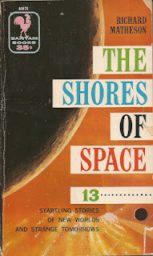 Shores of Space, Bantam A1571. (I didn’t have time to hunt through the shelves for something with a good cover.) In honor of my cheapness and of the man who wrote Vincent Price’s best movie and Steven Spielberg’s best movie, let’s read three stories from this freebie.
Shores of Space, Bantam A1571. (I didn’t have time to hunt through the shelves for something with a good cover.) In honor of my cheapness and of the man who wrote Vincent Price’s best movie and Steven Spielberg’s best movie, let’s read three stories from this freebie.
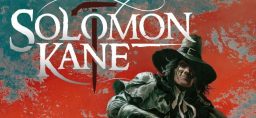 Comic Books (Daily Dead): Written and illustrated by Patrick Zircher, Solomon Kane: The Serpent Ring #1 will be released by Titan Comics and Heroic Signatures on March 26th. It’s Solomon Kane’s first solo series in fifteen years, and we recently caught up with Zircher, who told us all about the new series, his love Solomon Kane and the world of Robert E. Howard, and much more. We also have a preview of the first issue you can check out below!
Comic Books (Daily Dead): Written and illustrated by Patrick Zircher, Solomon Kane: The Serpent Ring #1 will be released by Titan Comics and Heroic Signatures on March 26th. It’s Solomon Kane’s first solo series in fifteen years, and we recently caught up with Zircher, who told us all about the new series, his love Solomon Kane and the world of Robert E. Howard, and much more. We also have a preview of the first issue you can check out below!
Fiction (Vintage Pop Fictions): Cornell Woolrich’s Rendezvous in Black was published in 1948. Woolrich’s particular genius is that his stories were so perfectly adapted to film adaptation. Very few writers have had more stories adapted for film and TV and that made him a crucial figure in the history of pop culture. And it turned out to be almost impossible to make a bad movie from a Cornell Woolrich story.
Horror (Wormwoodiana): The early 1920s were fruitful years for Arthur Machen. Fuelled by a heightened interest in the United States his work was in demand, with publishers scrambling to bring out new books and reprint old ones. Machen provided introductions and prefaces for these editions, some of which were limited and signed, aimed at collectors and priced accordingly. An American edition of The Shining Pyramid appeared in 1923.
Folklore (History Debunked): Ask people today to describe fairies and you are very likely to be given a description of something similar to Tinkerbell from the book Peter Pan. A cute little thing about six inches high, wearing a white dress and with delicate, gossamer wings. Typically, such a being would be about the size of a Barbie doll. In short, something which would not look out of place perched on top of a Christmas tree. This idea of fairies, widespread and common though it is, dates only from the seventeenth century.
Horror (Too Much Horror Fiction): Thus is the setup for the stories in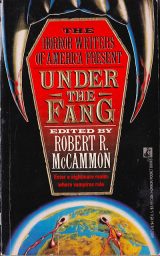 Under the Fang (Pocket Books, Aug 1991, cover by Mitzura), under the auspices of the Horror Writers of America coalition, with editing duties by iconic bestselling paperback author Robert R. McCammon. Akin to the zombie apocalypse anthos based on George Romero’s movies, Book of the Dead (1989) and Still Dead (1992).
Under the Fang (Pocket Books, Aug 1991, cover by Mitzura), under the auspices of the Horror Writers of America coalition, with editing duties by iconic bestselling paperback author Robert R. McCammon. Akin to the zombie apocalypse anthos based on George Romero’s movies, Book of the Dead (1989) and Still Dead (1992).
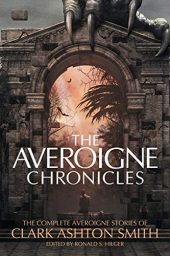 Clark Ashton Smith (Sprague de Camp Fan): This 252-page Hippocampus Press paperback was published in 2013. There is an excellent introduction by the late great Gahan Wilson and an afterword by Donald Sydney-Fryer. This volume includes all of Smith’s tales that concerned the fictitious medieval French province of Averoigne with a generous sampling of his beautiful poetry. There is a fine map of Averoigne and I thought it was very nice that the book is dedicated to Lin Carter and Gahan Wilson.
Clark Ashton Smith (Sprague de Camp Fan): This 252-page Hippocampus Press paperback was published in 2013. There is an excellent introduction by the late great Gahan Wilson and an afterword by Donald Sydney-Fryer. This volume includes all of Smith’s tales that concerned the fictitious medieval French province of Averoigne with a generous sampling of his beautiful poetry. There is a fine map of Averoigne and I thought it was very nice that the book is dedicated to Lin Carter and Gahan Wilson.
Ghost Stories (Old Style Tales): Since I am less acquainted with the postwar canon, many of these tales are rarely read gems to whom I happened to take a shine. Of course there are many classics here as well – Aickman, Bradburry, Campbell, Derleth, Lieber and Oates – but the number of lingering, tightly-written fantasias included here which have only been anthologized three or four times should be something of a scandal to publishing.
Sherlock Holmes (Paperback Warrior): Enjoying the first Sherlock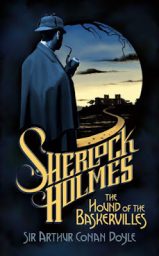 Holmes novel, A Study in Scarlet, I decided to read and review another of the Holmes novels. The Hound of the Baskervilles is the third of the four Holmes novels authored by British writer Arthur Conan Doyle. It was originally serialized in The Strand Magazine from August 1901 until April of 1902. It was published by George Newness as a hardcover in March of 1902.
Holmes novel, A Study in Scarlet, I decided to read and review another of the Holmes novels. The Hound of the Baskervilles is the third of the four Holmes novels authored by British writer Arthur Conan Doyle. It was originally serialized in The Strand Magazine from August 1901 until April of 1902. It was published by George Newness as a hardcover in March of 1902.
 Art (Rough Edges): I’ve become a big fan of Ron Lesser’s artwork in the past few years. Well, actually, I’ve been a big fan of Ron Lesser’s artwork for about 60 years, because that’s how long ago it was when I first started noticing it on paperback covers as I avidly looked through the new books on the spinner racks, searching for the next one I was going to read.
Art (Rough Edges): I’ve become a big fan of Ron Lesser’s artwork in the past few years. Well, actually, I’ve been a big fan of Ron Lesser’s artwork for about 60 years, because that’s how long ago it was when I first started noticing it on paperback covers as I avidly looked through the new books on the spinner racks, searching for the next one I was going to read.
T.V. (Grave Tapping): Back in the ’90s cheesy syndicated action television series were everywhere. And man, I was a fan. One of my favorite channels of the era was Salt Lake City-based KJZZ, Channel 14. Its Saturday night lineup was Kung Fu: The Legend Continues, Renegade, and the uber ridiculous but entertaining game show, American Gladiators. So when I saw this advertisement from an old issue of the Salt Lake Tribune (Nov. 7, 1993), I had to share.
syndicated action television series were everywhere. And man, I was a fan. One of my favorite channels of the era was Salt Lake City-based KJZZ, Channel 14. Its Saturday night lineup was Kung Fu: The Legend Continues, Renegade, and the uber ridiculous but entertaining game show, American Gladiators. So when I saw this advertisement from an old issue of the Salt Lake Tribune (Nov. 7, 1993), I had to share.
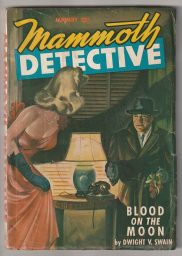 Pulp (Spectre Library): Quite a while ago I read a wartime issue of Mammoth Detective and it had me wanting for more. Fortunately, I had another issue in storage, but from the postwar era. Eagerly I dove into the lead novella.
Pulp (Spectre Library): Quite a while ago I read a wartime issue of Mammoth Detective and it had me wanting for more. Fortunately, I had another issue in storage, but from the postwar era. Eagerly I dove into the lead novella.
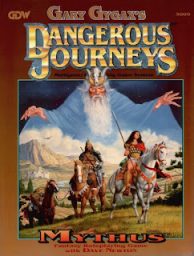 RPG (Grognardia): By the end of 1986, Gary Gygax had completely severed any connection to TSR, the company he’d founded in 1973 with Don Kaye. His departure was not entirely of his own accord, having lost both financial and creative control over TSR a year earlier to his former business manager, Lorraine Williams.
RPG (Grognardia): By the end of 1986, Gary Gygax had completely severed any connection to TSR, the company he’d founded in 1973 with Don Kaye. His departure was not entirely of his own accord, having lost both financial and creative control over TSR a year earlier to his former business manager, Lorraine Williams.
Crime Fiction (Rough Edges): Stark House has reprinted two more of Robert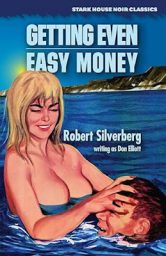 Silverberg’s soft-core novels published originally under the name Don Elliott. Most of these were actually hardboiled crime yarns with some sexual elements, and that’s true of the latest double volume. I just read EASY MONEY, Silverberg’s title for a novel published under the Elliott pen-name as FLESH PAWNS in 1964.
Silverberg’s soft-core novels published originally under the name Don Elliott. Most of these were actually hardboiled crime yarns with some sexual elements, and that’s true of the latest double volume. I just read EASY MONEY, Silverberg’s title for a novel published under the Elliott pen-name as FLESH PAWNS in 1964.
Edgar Rice Burroughs (Black Gate): Like many pulp writers of his day, ERB dipped his toes into the western genre. He wrote four: two pretty standard ones and two that incorporate the Native American experience. He knew something of what he wrote, having worked on his brother’s ranch in Idaho at age 16, and having served with the 7th cavalry in Arizona in the late 1890s.
Crime Fiction (Pulp Fiction Reviews): In his last novel featuring his Quarry tale, Collins introduced his Vietnam veteran protagonist to the adult daughter he’d never known. After an awkward start, filial emotions rose to the surface when they were forced to save each other’s lives from some very bad people. In this follow up tale, Quarry learns Susan, his crime-writer daughter, has disappeared while doing research on a serial killer.
Collins introduced his Vietnam veteran protagonist to the adult daughter he’d never known. After an awkward start, filial emotions rose to the surface when they were forced to save each other’s lives from some very bad people. In this follow up tale, Quarry learns Susan, his crime-writer daughter, has disappeared while doing research on a serial killer.
 Fiction (Goodman Games): John Anthony Bellairs was born on January 17th, 1938 in Marshall, Michigan, which he described as “full of strange and enormous old houses, and the place must have worked on [his] imagination.” A shy and overweight child, he “would walk back and forth between [his] home and Catholic school and have medieval fantasies featuring [himself] as the hero.”
Fiction (Goodman Games): John Anthony Bellairs was born on January 17th, 1938 in Marshall, Michigan, which he described as “full of strange and enormous old houses, and the place must have worked on [his] imagination.” A shy and overweight child, he “would walk back and forth between [his] home and Catholic school and have medieval fantasies featuring [himself] as the hero.”
History (Frontier Partisans): Warren Angus Ferris called the Free Trappers “Freemen” in Life in the Rocky Mountains: There are about three hundred men, who compose the roving, hunting parties in these regions, excluding those, who remain principally at the several forts or trading posts, on the east and west sides of the mountains.
History (With Both Hands): Now comes Peter Heather of the University of Oxford (Worchester College) with this delightful attempt at a new synthesis. Yes, we are assured, the Roman Empire did fall. Indeed, in the very specific way in which the author frames the issue, we are even assured that the date in the old textbooks for the fall of the empire in the West, AD 476, is actually a pretty good approximation.
(Worchester College) with this delightful attempt at a new synthesis. Yes, we are assured, the Roman Empire did fall. Indeed, in the very specific way in which the author frames the issue, we are even assured that the date in the old textbooks for the fall of the empire in the West, AD 476, is actually a pretty good approximation.
Please give us your valuable comment